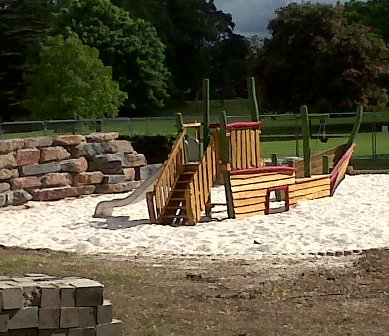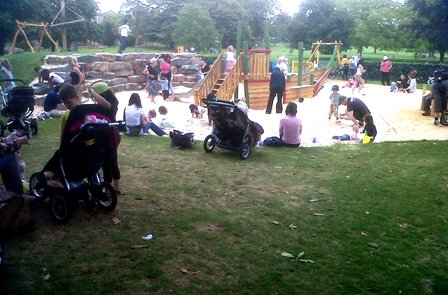Ian Brooke: head of service with parks and play in his remit
Parks, play and practicalities
With spring about to burst out all over, The Leisure Review visited Ian Brooke, head of leisure at Oxford City Council, to discuss risk in play, how to be inventive with maintenance budgets and the future of parks as a political touchstone.
Ian Brooke: head of service with parks and play in his remit
Ian Brooke is head of leisure services at Oxford City Council, a remit that includes seven leisure centres, the city’s sports development function, hosting the county sports partnership, parks, countryside, cemeteries, allotments and play. From the windows of Brooke’s office one can see the recently refurbished and extensively remodelled play area of Bury Knowle park, mention of which in the editorial of our recent December/January issue prompted him to invite The Leisure Review to make the five-minute journey from our office to his for a cup of tea and some insight into how this hugely popular project had come to fruition.
It goes without saying that all aspects of Brooke’s job are of interest to The Leisure Review but, having reluctantly truncated a discussion about how cemeteries fit within a leisure department, a conversation to be had another time, we agreed that with time pressing we focus on the subject in hand, namely children’s play. The article which sparked our conversation had, Brooke explained, articulated a number of points regarding the value of investing in parks and play that had been much in his mind. Its publication had also been timely in light of a number of discussions that were taking place within the council. He suggested that Bury Knowle offered an interesting case study of how the city’s play facilities had been subjected to a rigorous reassessment and extensive reinvestment.
Work had begun on the complete overhaul of the Bury Knowle play area shortly after the national government had announced that public services were to be subjected to fierce austerity measures; it also happened to be precisely the time that the impact of these measures had begun to be felt by local authorities across the country. As the headlines spoke of slashed spending, this local park began a major refit. How, local residents wondered as they walked past the contractors installing equipment stores, protective fencing and earth-moving machinery, had Oxford City Council been able to undertake such investment in such dire times?
As Brooke explained, the arrival of the contractors at Bury Knowle was the culmination of a lengthy evaluation of the city’s play facilities. “There are 92 play areas across the city and four years ago – which was a little while before I arrived – the administration decided that they were pretty poor across the board. In essence our play offer was dull, bullet-proof and rather unimaginative, plus the sites weren’t maintained as well as I would have wanted them to be. However, the council took a decision to take all our repair and maintenance monies, because repair costs were going up as the equipment was getting older, use some of our capital reserves and see how much we could muster. We got a decent organisation to support us – Groundworks Thames Valley have been working with us over the life of the project – and we did a lot of work on condition surveys and updating our play policy, a key focus of which was asking: what is modern play?”
The condition surveys showed that the city had 69 play areas that needed short-term works. They started with a budget of £2.55 million, which had come from a combination of repair and maintenance monies, and developed a programme with Groundwork Thames Valley to improve all these sites. Successful bids to a variety of funding sources and partners, including the county council, grew the budget to some £3.1 million, and the programme of works was scheduled over four years.
“It’s always a difficult process but for us the consultation, which proved to be excellent, was fundamental. As open space specialists, Groundwork led the consultation process and we worked very closely together, to the extent that their project manager, sits in the office next door. Simply put, we wanted the right play areas in the right sites so if some of the tatty ones were a street apart we didn’t replace them, but if there was a busy road between them we’d keep them. We worked on the principle that if there was a piece of equipment that was good in that play area we didn’t get rid of it for the sake of it. We also listened to the consultation, shaped the programme accordingly and really pushed on finding what external funding we could bring in.”
By April 2012 the project should be complete, with Florence Park or Blackbird Leys the final site to be reopened, although a debate regarding ‘town green’ status for the latter site may yet delay this completion date. Bury Knowle’s play area was officially opened towards the end of last summer with local MP Andrew Smith among those celebrating a play space that had already become a much-used and much-loved part of the local community. The huge footfall within the Bury Knowle play area suggests that the designers have done their job admirably and the layout is noticeable for the number of challenging play features, which, for anyone who has sat through interminable conference debates on the management and insurance of risk within outdoor play (and The Leisure Review has endured more than its fair share), is a refreshing approach to what constitutes an interesting and engaging play space.
Ian Brooke acknowledged the point and explained that it was noticeable from the consultation that the design options that tended to be most popular with park users were those that offered more inspiring landscapes and equipment, rather than the designs that were rather more bland and what some might term safer. The preferred designs also happened to reflect the views of Play England, the national organisation that campaigns for play space for children, which advocates natural play and an understanding of appropriate risk.
“There has been a national policy push against the ‘cotton-wool culture’ recently,” Brooke said. “Our policy review asked: what is play? And we recognised that there has to be an element of risk for play to be exciting. If you bundle a child up in a 100%-safe environment how enthused, how inspired is that child going to be? Probably not much. Of course, we’re mindful of health and safety. We check the playgrounds every single week and we make sure they are as safe as we can possibly make them but you have to remember that lots of play is developed from what used to be used, which was often trees. There was an element of risk when kids used to climb trees, which has all but stopped, but our most popular pieces of play equipment have always been felled trees. Natural play is all about providing a certain type of environment. Simple things such as mounding can create a really interactive area for play.”
The design and remodelling of Bury Knowle has resulted in a huge growth in usage and, as far as Brooke is aware, there have been very few accidents; perhaps one arm fractured on one of the more adventurous pieces of equipment since reopening.
“You’ve seen the evidence here. Sometimes I’ve walked across the park to the shops, done a quick head count in the play area and there can be around 200 people here. Then you look round and there’s families picnicking; and then those families interact. It’s a pretty safe environment but if we take away every risk, if it becomes so structured it’s almost not play. You mentioned in your article your daughter and her scar. She had taken a bit of a risk but she’s OK. Even if you take everything away to leave a flat area of grass children are still going to fall over.”
If the debate over the eradication or acceptance of risk in play has moved on, The Leisure Review wondered how the campaign for parks, which proved such a success after the dark days of neglect and slashed funding during the 1980s and 90s, is faring now that public funding is once again under attack. Brooke’s view was not encouraging but Oxford’s experience does, he argued, offer some ammunition for the defence.
“Greenspace did a survey looking at how parks had been impacted and nationally I think they are getting a bit of a bashing. The political aspect of your article made the case for parks but we need more tangible research to argue against piecemeal investment. We have demonstrated that even with changes to national funding you can still bring in monies from various pots and the impact you can make by doing it as a package is phenomenal. I talk to people up and down the country and many seem to be still chipping away, still struggling. I haven’t come across another example where they have pooled all the monies and undertaken a major overhaul but there must be some out there. Of course, it might be because they weren’t in the state that we were in, where so many sites need so much
work, but I doubt it.”
Brooke again acknowledged the support of Groundwork, who helped access significant funding and supplied invaluable experience, but he was also adamant that one has to be clear about the political potential of parks.
“This work fits with at least two of the council priorities: children and young people, and inclusivity. Lots of councils have similar priorities, often with a focus on children and young people, and parks can tick those boxes. With an approach that focuses on capital investment and the reduction of an annual repair and maintenance budget, you can then make quite a strong business case to go with the political case. This was certainly how it was for Oxford and I would guess it could be the same for other places.”
From the window we were able to see the first of the day’s visitors pushing through the gates of the play area to choose their own challenges. “This park has recently received a Green Flag which gives a bit of community pride,” Brooke said. “You look at the amenity value out there and I’ve got every confidence that we are sweating the amenity value out of this park. We’re maintaining it, we’re keeping it clean and we’re keeping it safe but I think we’re doing much more than that.”
The original article that inspired this conversation was the Dec/Jan 2011/12 editorial.
The Leisure Review, March 2012
© Copyright of all material on this site is retained by The Leisure Review or the individual contributors where stated. Contact The Leisure Review for details.
Download a pdf version of this article for printing

The Bury Knowle ship on the sandy slipway before launch

And after the official opening, taking on numerous boarders.